Central College Mérida opened its doors in 1968 and welcomed hundreds of students to Yucatán’s capital city during its 52-year history. The program was closed on Dec. 31, 2020, along with four other director-led study abroad programs the college ran across the world. In this short piece, I narrate a brief history of the program, highlighting individuals who were instrumental in initiating and maintaining the program for more than five decades.
Given the space limitations, I did not attempt to be comprehensive. I collected material from personal interviews with Jim Graham in Sierra Vista, Arizona, and with George Ann Huck, Beatriz Alcocer, Claudina Castillo Alcocer, Valerie Grimsley ’76 and Lisa Munro in Mérida, Yucatán, between November 2020 and February 2021. My husband, Tomas, and I have spent many weeks in Mérida since 2007, usually on sabbatical leave from Allegheny College in Meadville, Pennsylvania. I have kept close contact with Huck since I studied in the program in the spring of 1988. We spent January and February 2021 in Mérida. It seemed like a small miracle to be able to talk in person to these individuals during those months of COVID-19 uncertainty and constraints. I also heard from several former students via Facebook. The program had a significant impact on many students. For some of us, it changed our lives, our career paths and our way of understanding ourselves and our country.
It was Professor Harriet Heusinkveld ’39 who first proposed the idea of Central in Mérida in the mid-60s and got the program off the ground. Professor Huck became its long-time director — the program’s “on-the-ground” Central representative and mainstay. A professor of Spanish language and literature, Huck was hired in 1967 with the expectation that she would run the Mérida program. She had prior experience in Mexico, she spoke Spanish fluently and she was really interested in running the program, she told me over many cups of coffee in Mérida. Huck remembers her job interview at Central in 1967 well. She told me that she dressed extravagantly, “as a hippie,” during the interview process so the “president and dean would understand that I was not a conservative.” Those of us who know Huck might find it hard to imagine that anyone would mistake her for a conservative, even if dressed in business attire! Central administrators were apparently not deterred by her choice of clothing.
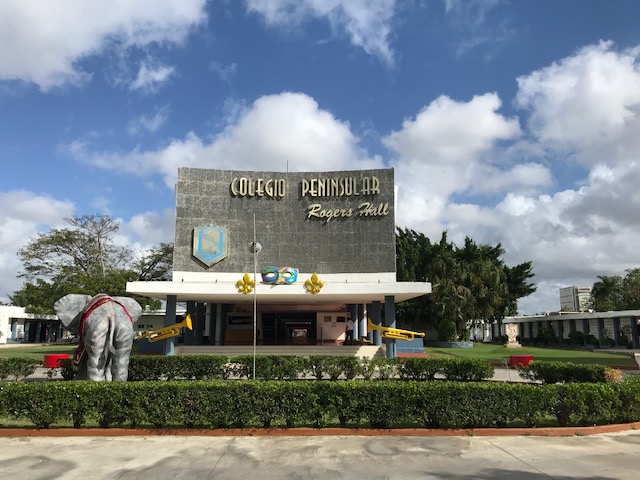
Central College Mérida was housed at Rogers Hall from 1968-75.
Between Huck’s hire and the official beginning of the program, several important steps remained. One of the first big issues to tackle was the question of where the students would be housed. Rogers Hall, a Maryknoll Sister-run elementary and high school for middle and upper-middle class Yucatecan girls, was ultimately chosen, but, as Graham, former dean of the college and Central professor of English, confessed, “It was not perfect. The nuns were worried about housing American students, given their different customs and culture. And they were right to be worried.” Graham’s laugh echoed across the telephone wires. Even at age 95, Graham’s wry sense of humor is intact and characteristically on-point. Grimsley, who studied at Rogers Hall in the spring of 1975, years before she became program director, has a few stories about scaling the walls of Rogers Hall after hours, clearly illustrating that the sisters’ fears were well-founded!
Even while Central students and their professors didn’t interact much with the Yucatecans, it was fitting that Central students and their professors were housed in a school run by American nuns. The “sisters” taught the Yucatecan girls the basic required subjects, but the school also educated the girls to be open-minded, “liberales.” The first Central cohort arrived at Rogers Hall in the fall of 1968.
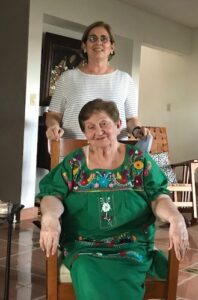
Doña Beatriz Alcocer with her daughter,
Claudina Castillo Alcocer, in February 2021.
Alcocer, known to generations of Central students simply as Doña Beatriz, was a pillar of the program from its inception in the fall of 1968 until she retired in 2000. In the 1960s, Alcocer and her late husband, both ardent Catholics, worked closely with the sisters on Catholic social welfare projects in the poor eastern sector of Mérida — Oriente. Alcocer and her family also lived two blocks from Rogers Hall. When Alcocer’s husband became sick, the nuns invited her to do some cooking for them at the school, anticipating her financial need as the head of a household with seven young children.
A semester after the program officially began in the fall of 1968, Huck, Professor Larry Mills and professors Don and Maxine Huffman embarked on a convoy, which included three cars and several Central students, from Pella to Mérida. There was not an all-weather road that connected Mérida to Mexico City, so, in retrospect, it was good that the rainy season was over! Huck told me that the caravan traveled south on Interstate 35 through Laredo, Texas, into Mexico. After several days of travel, their last overnight stay before arriving in Mérida was a night in Villahermosa, Tabasco, where their “hotel” turned out to be a brothel, which they only discovered in the middle of the night when fights broke out on several of the balconies between women and their clients. It only then dawned on our naive professors, who had rented out hourly rooms. Either way, we can probably blame this on Huck, given that she was the only one in the group who spoke much Spanish!
When Central Mérida opened its doors in the fall of 1968, the city of Mérida had 253,000 residents. Rogers Hall (now el Colegio Peninsular) is in the north of the city, about a 15-minute walk from the Central House in Colonia Mexico that so many of us knew. In 1968, Rogers Hall was on the prosperous periphery of the city proper and was quite far from the city center. The north of Mérida has always been where the wealthier classes of Mérida live, as they moved away from the city center, beginning in the 1930s-40s.
When the program was officially shuttered at the close of 2020, the city had grown to over a million people. The Central House was now in the near north, and the city had sprawled kilometers further to the north as gated communities and new residential neighborhoods proliferated. We, generations of Central students who studied in Mérida, bore witness to the incredible transformation of the city, even while the city and our experience there transformed many of us in significant ways. In the 1980s, there was only one place to go dancing that was anywhere near to the Central House and only one air-conditioned café in downtown Mérida: la Cafetería Pop, which readers will be happy to know is still open for business! Incidentally, there also was only one telephone (rotary) in the Central House that we could use to make or receive calls, which seems rather unbelievable today, given the ease of communicating with friends and family in the U.S. from Mexico on personal cell phones.
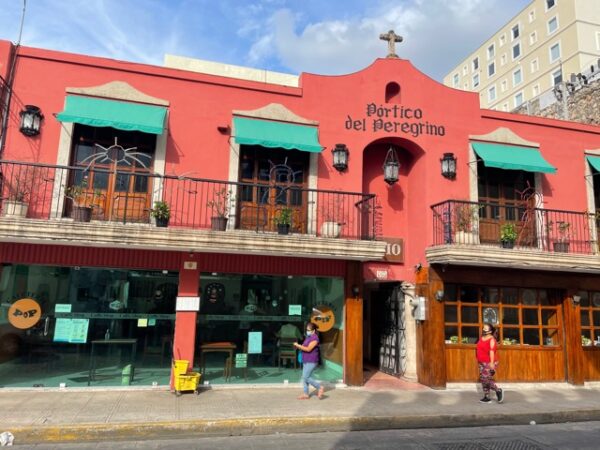
Cafetería Pop is still open for business!
When the college bought the former governor’s mansion on Circuito Colonias (Calle 21) at Calle 17 in 1975, Alcocer became house manager and Huck, of course, continued to serve as program director. Now into her 90s, Alcocer remains gracious and attentive, making sure that I was accurately getting all the details during a conversation on her porch in February 2021 over tea and homemade sugar cookies. Alcocer told me that as house manager, her day began around 6:30 a.m. at the Panadería Montejo, where she bought the many loaves of French bread the students would consume over the course of the day. Then on to the Central House where many of us remember her holding forth with Huck over coffee when we arrived to consume some of that warm bread and jam. In addition to supervising the house employees, Alcocer attended to many of the details that made the program run so smoothly. She did the shopping and created the menus for our three daily meals, in addition to making sure there were adequate hard-boiled eggs, bananas and peanut butter and jelly sandwiches for our excursions to Izamal; Chichén Itza; Uxmal; Maní; and Dzbilchaltún on that terribly uncomfortable yellow school bus, which undoubtedly was a hand-me-down from some school district in the U.S. that had long since upgraded its model! Alcocer told me that she still is unable to eat strawberry jam after years of assembling those sandwiches for us! Alcocer’s extensive knowledge of Mérida society and her “Rolodex” of contacts greased the wheels of the program and helped Central establish a place for itself within the city. Central in Mérida was a known quantity by many of the movers and shakers in Mérida, which is due in no small part to Alcocer.

George Ann Huck at her neighborhood café
in January 2021.
And George Ann Huck. Where to begin? Quite simply, Huck was the heart and soul of Central Mérida. She was a gatekeeper, professor, interpreter of language and of culture, fearless and a font of knowledge and opinions about Mérida, Meridanos and all things Yucatecan. To this day, she is one of the most curious people I know. And she was not coy about encouraging us to be curious, too. John Lucas ’92, who studied in Mérida in 1990, related this story about one weekend he found himself alone in the Central House when his classmates had gone off to Cancún:
“George Ann would not tolerate moping around the grand mansion on my own,” Lucas says. “She put me in a taxi, dispatched me to the bus station and off to a Mayan village to meet her friend, Don Chivo (old Mr. Goat, they called him). I said, ‘But George Ann, when I get there, how will I know which one is him?’ She laughed, ‘Juanito, he’ll know who you are, of course,’ likely the only awkward gringo to stumble off the local bus around midnight. She just assumed that I was brave enough to explore, and so I borrowed her faith in me and plucked up the courage.”
Many of us came to Mérida very naive — inocentes; perhaps it was even our first plane flight. Most of us had never been to Mexico and knew very little about the country. Some of us spoke Spanish, but many of us did not. Some of us travelled with beloved professors and advisors who were teaching a class in our major that trimester or semester. Some of us just wanted to spend the winter trimester in a warm clime. Some of us, from a now bygone era, sat on the beautiful open porch of the Central House drinking refrescos (sodas), bottled in thick, heavy Topo glasses, noting our consumption on a list that was attached to the refrigerator.We sweated and wrote in our journals. Some of us (actually, just Suzy Felando), took a case to small claims court … and won despite the odds! Some of us wrote letters home on wafer-thin blue airmail envelopes or read and reread letters from home. We wondered if we would get a call that day or if we would make one. We (actually, just Kirsten Walker) wondered whether Señora Candelaria would ruin the color of our undergarments again with too much Fab! We waited for our next meal or made plans to have an ice cream or sorbet at Sorbetería Colon on the Paseo. We planned our next excursion and did some reading for class. We ordered pizza from Messina’s in Itzimná. We wondered if Huck would take us to task for wearing a too-short skirt. Some of us practiced our Spanish with the many pretendientes (suitors) — young men, mostly, who wanted also to practice their English with impossibly blond Iowa girls. If all this seems somewhat gendered and old-fashioned, that’s because it was. Mérida was, and still is to some extent, one of the most conversative capital cities among Mexico’s 32 states. It was, and largely remains, very Catholic, hierarchical and traditional. Despite our variety of experiences, virtually all of us gained a different perspective on the United States after spending time in Mérida. And most of us came home with a very warm feeling about Yucatecos and their immense hospitality and open spirit toward gringos.
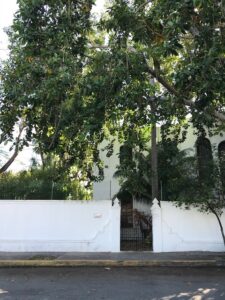
The Former Governor’s Mansion and Central
College Mérida House from 1975-2018.
One of the things that all the directors of the program — George Ann Huck (1968-2006), Val Grimsley (2008-2018) and Lisa Munro (2018-2020) — had in common was a deep commitment to teaching about intercultural differences. Huck, Grimsley and Munro all talked to me about their efforts in helping students see the U.S from the perspective of Mexico and from the global south. After the North American Trade Agreement went into effect in 1994, Mexico started to look more like the U.S., and the cultural differences were perhaps more subtle. Whether we studied in Mérida in the 1970s or the 2000s, we learned so much about ourselves and our country and, if we put our minds to it, learned something about Mexico, too!
Central’s program in Mérida rested on the strong and sustained support of the administration and the faculty. In addition to Dean Graham, President Ken Weller was a key booster. Among the faculty, Jim Schulze stands out, as do Maxine and Don Huffman, John Bowles, Larry Mills, Bob Schanke and many others who spent a trimester, a semester or many more with students in Mérida, drawing on their own expertise to craft a class that incorporated Mexico and Yucatán into the subject matter. In the spring of 1988 when I studied in Mérida, Jim and Louise Zaffiro stretched themselves beyond their personal and intellectual comfort zones to teach a class on Mexican food policy. They made some very dry policy texts seem interesting and important.
We all owe so much to so many for keeping this program going and thriving for 52 years. So many of us will be indelibly shaped by our experience in Mérida with Central. Fifty-two years was a good run, and although many of us wish the program was still running in the same capacity it once did, we are grateful to have been part of it.

Parque de las Americas, a popular and beautiful local park in Mérida.
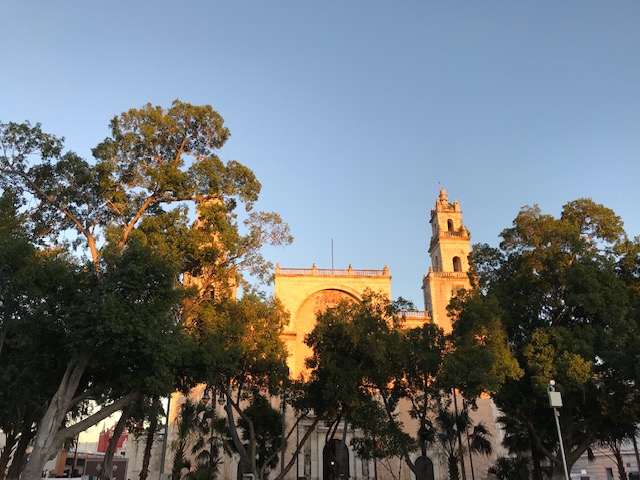
Mérida’s Cathedral, one of the oldest in the New World.











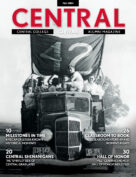
To encourage serious, intellectual discourse on Civitas, please include your first and last name when commenting. Anonymous comments will be removed.
Kim Huffman
|
11:38 pm on July 13, 2022
Professor Harriet HEUSINKVELD
CENTRAL COLLEGE. Please use a fact checker
Kim Huffman
|
11:38 pm on July 13, 2022
Professor Harriet HEUSINKVELD
Please use a fact checker